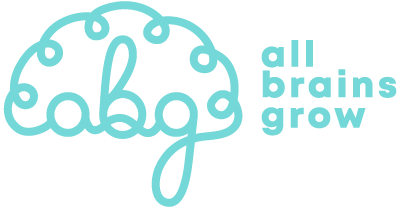Autism has gotten more recognition over the years — whether that’s through pop culture, autistic people speaking up, or more advocates for neurodiversity. While this has resulted in more research, therapies, and support, it also means that there are more theories about what autism is and what causes it. At All Brains Grow, we not only work with families with autistic kids, we’re part of neurodivergent families. You need to know the science behind autism, but even more importantly, you need to know how to actually support your autistic child (it might not be what you think).
What is Autism?
Autism is a neurodevelopmental disorder with two main features: challenges in social communication and interaction and repetitive behaviors or interests. These can show up in many different ways, like struggling to share interests or not picking up on social cues, trouble with nonverbal communication, and having specific routines or fixations.
It might mean your child finds it harder to share their toys or understand when someone else wants to play. They might also have trouble with things like eye contact or understanding when someone is happy or sad. It could mean your child likes doing the same thing over and over again, like flapping their hands or lining up tor in a row. Usually, autistic kids like sticking to the same routines every day.
But here’s the thing: autism isn’t the same for everyone. That’s why we call it a spectrum. Each person with autism is unique. They learn, play, and express themselves in their own special ways. Some might need lots of support d, while others might need just a little. That’s why you might hear people say, “If you’ve seen one child with ASD, you’ve seen one child with ASD.” Every person with autism is different, and we need to understand and support each of them in their own way.
What Causes Autism?
This is where it gets tricky — we don’t know what causes autism. Brains are complicated machines, and there are many different parts that work together to make it run smoothly. Researchers believe that autism happens because some of these parts don’t work exactly the same way as they do in other people’s brains.
They don’t know which parts of the brain work differently, but the general consensus is that the instructions that tell our bodies how to grow and work (genes) can make it more likely that someone will have autism. Just like you might’ve passed down your eye color or smile to your baby, you might’ve passed down autism.
Environmental factors, meaning anything around us, could also trigger this gene, but scientists aren’t yet sure what those are.
What we do know is that there are genetic and environmental reasons a child develops autism and that it is not caused by bad parenting.
Brain Differences in Autism
Being autistic doesn’t mean that your child has an illness or disease. It means your child’s brain works differently from other “neurotypical” brains.
Now why does your child’s brain work differently? Let’s take a look at what’s happening inside autistic brains.
Altered Connectivity
Think of your child’s brain as a big network with different parts. In autistic kids, some parts are connected more, and others are connected less than in neurotypical brains, especially in areas of the brain responsible for social cognition, language processes, and sensory perception. This can affect how your child understands and interacts with the world.
Differences in Gray Matter Volume
Your child’s brain might have some areas that are bigger or smaller than usual. These areas could be important for things like social skills, problem-solving, or processing sensory information.
Atypical Brain Development
As your child grows, parts of their brain might grow at a different pace from other kids’. This can impact their learning, behavior, and how they see the world.
Functional Abnormalities
Imaging studies have shown that autistic brains respond to various stimuli differently than neurotypical brains. When your child’s brain reacts to sights, sounds, or emotions, it might respond differently than other brains.
Neurotransmitter Imbalance
Your brain uses tiny chemicals called neurotransmitters to send messages. Sometimes the balance of these chemicals is different in kids with autism, which can change how brain regions communicate, resulting in different moods, behavior, and thinking.
Understanding these things about your child’s brain can help you better support them. It’s like having a roadmap to know why they do what they do and how you can help them navigate their world uniquely.
How To Help Your Autistic Child
There is currently no one standard care for ASD. Still, there are many ways to help minimize the symptoms and maximize abilities. Keep in mind that the most effective therapies are usually different for each autistic person. These therapies include:
- Behavioral
- Developmental
- Educational
- Psychological
- Pharmacological
- Alternative approaches
Behavioral Therapies
Behavioral therapies aim to reinforce wanted behaviors and reduce unwanted ones. They focus on understanding what is happening before and after the problematic behaviors. They often use techniques like Applied Behavior Analysis (ABA), which can include different teaching styles like Discrete Trial Training (DTT) and Pivotal Response Training (PRT). These teaching styles generally encourage desired behaviors and discourage undesired ones by tracking progress to improve various skills.
Developmental Therapies
There are many types of developmental therapies, each concentrated on improving a specific skill. Most parents of autistic kids are familiar with speech and language therapy to improve communication and occupational therapy, focusing on everyday tasks. Often, occupational therapy incorporates Physical Therapy to improve body movements and Sensory Integration Therapy to make it easier for your child to respond to overwhelming sensory input.
Educational Therapies
Educational therapies are delivered in a classroom setting. One example is the TEACCH approach, which is evidence-based and tailored for autistic individuals who are often visual learners. TEACCH emphasizes structure and organization, following five principles: physical structure, scheduling, work system, routine, and visual structure. Teachers adapt the classroom environment based on these principles.
Psychological Therapies
These therapies help with mental health issues like anxiety or depression. Cognitive Behavioral Therapy (CBT) is one approach that focuses on changing thoughts and behaviors to manage emotions and reactions.
Pharmacological Therapies
While there are no medications specifically for ASD, some drugs can help manage symptoms like attention difficulties, high energy levels, or self-harming, as well as co-occurring psychological symptoms.
Alternative Therapies
Another option is complementary and alternative therapies, which are becoming more scientifically supported. Neurofeedback Therapy is a non-invasive approach that promotes healthier brain activity patterns by monitoring brainwave activity and providing immediate feedback through visual or audio cues. It aims to achieve a more optimal balance of brainwaves and connectivity for better brain functioning, which is particularly beneficial for individuals with ASD.
Remember, finding the right combination of therapies for your child might take some time, and what works for one child may not work for another. But with patience, love, and support, you can help your child thrive on their autism journey.
See The Beauty In Autism
While you might worry about your child’s social skills, communication abilities, or repetitive behavior, remember your child’s diversity is their strength.
- If you’re afraid that your child can’t make friends because of their social skills, remember autistic people can be very social if you open your eyes to a new way of being friends.
- If you worry that your child won’t ever communicate because they’re non verbal, wait until you discover how much they have to share once you accept all the different forms of communication.
- If you think your child doesn’t care about you because of their poor eye contact, remember they see you clearer than you see yourself without needing to meet your eyes.
- If you’re concerned that your child can’t be successful in the world because of their repetitive behaviors, remember they just find repetition comforting and it doesn’t define them.
- If you’re sad that your child doesn’t like affection because of their sensory sensitivities, remember that there are many different ways to express affection.
- If you’re anxious that your child can’t think of anything other than their obsessive interests, remember their interests will guide you in how to teach them how the world works.
- If you’re afraid you can’t relate to your child because all they do is stim and flap their hands, remember to join them and enjoy the experience. That’s how you’ll start relating.
- If you worry that your child can’t learn anything because of their learning differences, remember their learning process can be fascinating, fun, and fast if you’re creative.
Autism is more than your fears. Don’t let the diagnosis stop you from discovering the beautiful person.
How To Actually Support Your Autistic Child
Autistic individuals have their own beautiful way of experiencing the world, and with understanding and support, they can thrive and build meaningful connections.
Here’s how to actually help your autistic child:
Accept and love autism
Autism is a part of your child, who they are meant to be, and the only way you will ever both be happy or see results is if you learn to love your child AND their autism. The first step? Learn to not be embarrassed.
One experience of autism is just one experience of autism
Don’t define your child by their autism or their challenging behaviours. Your child is more than that. Learn to experience your child and their uniqueness.
They are more capable than you think
Autism has a lifelong impact but your child can grow to be capable and happy with the right support. Assume your child can do something and maybe they will because brains can change when you give them direction. Remember, your child can be smart and still struggle with behaviors.
Healing happens outside of therapies
Conventional therapies have a place but you’ll notice your child blossom the most outside of clinician’s rooms. Every day is a learning opportunity, give your child the opportunity to change and experiment in the real world.
It’s understandable to have fears and concerns when learning about your child’s autism diagnosis. Remember that autism is much more than its symptoms and it doesn’t define your child’s worth or potential.
Instead, celebrate your child’s strengths, appreciate their differences, and join them in their journey of growth and discovery. Autism is just one part of who they are, and with your support, they can lead a full life.
If you want to learn how to confidently support your autistic child, learn more about Heavenly Home here.
References:
1. American Psychiatric Association. (2013). Diagnostic and statistical manual of mental disorders (5th ed.). https://doi.org/10.1176/appi.books.9780890425596
2. Hodges H., Fealko C., Soares N. Autism spectrum disorder: definition, epidemiology, causes, and clinical evaluation. Transl Pediatr 2020.
3. Kim H, Keifer C, Rodriguez-Seijas C, et al. Quantifying the optimal structure of the autism phenotype: a comprehensive comparison of dimensional, categorical, and hybrid models. J Am Acad Child Adolesc Psychiatry 2019.
4. Wang C, Geng H, Liu W, et al. Prenatal, perinatal, and postnatal factors associated with autism: a meta-analysis. Medicine (Baltimore) 2017.
5. Johnson CP, Myers SM. Identification and evaluation of children with autism spectrum disorders. Pediatrics 2007.
6. Stoodley CJ, D’Mello AM, Ellegood J, et al. Altered cerebellar connectivity in autism and cerebellar-mediated rescue of autism-related behaviors in mice. Nat Neurosci 2017.7. Centers for Disease Control and Prevention. Autism Spectrum Disorder (ASD). https://www.cdc.gov/ncbddd/autism/treatment.html (2022).


